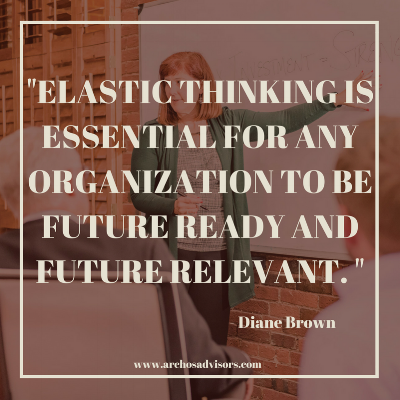
In the business environment, change is constant and future readiness is essential. To compete and be ready, we must develop new knowledge and skills to stay current with globalization, new applications of technologies, and the rapid pace of innovation in business models and products/services. However, to maintain relevance, we must also promote and engage in elastic thinking.
There are two types of thinking: analytic and elastic. When we are faced with everyday obstacles – business or other challenges with which we have familiarity or even facts to which we can relate, our brains naturally resort to analytical thinking. Processing data points and drawing upon regular and pre-existing frameworks we have previously relied on to make decisions are the foundation of analytical thinking. Using your analytical or logical mind to solve the “normal stuff” is easy and feels natural.
The most effective way of thinking to deal with the complex, unexpected, or new challenges is elastic thinking. Elastic thinking emerges from the subconscious when the brain is in a relaxed and often unfocused state, or when it is out of its element. It’s the level of thinking that unleashes innovation, creates new products or approaches, or identifies unique paths or niche markets. It is a powerful ally in the war for survival and sustainability that companies face.

Elastic thinking can be cultivated through:
- Space and time: Creating space and stepping away from an issue can break focus and allow the subconscious mind to intervene. This can be as simple as walking away for a short amount of time or scheduling “blue sky time” to free think or create. It can also occur by slowing the pace of a decision process and allowing for more contemplation or reflection.
- Reframing: Often reframing an issue by looking at it through a different lens or asking questions in a different way can create new possibilities. If the issue is internal, try looking at it through a customer’s point of view. If it is a customer complaint, flip it to see what a positive opportunity might lie within.
- Openness: In certain cultures, new or different ideas or even hard questions are frowned upon, made light of, or met with rigidity of thought. All of these reactions can inhibit creativity and ultimately send a message to team members that it’s not worth exploring new ideas or innovation. For elastic thinking to flourish, leaders have to have a willingness to hear it and stamp out cultural elements that are limiting.
To be competitive, to thrive, to be a disrupter and not the disrupted, are you changing how you think? Are you moving from analytical thinking to elastic thinking when needed and necessary?
Elastic thinking is essential for any organization to be future ready and “future relevant”. Make sure you are both by setting an example for promoting and engaging in elastic thinking today.

